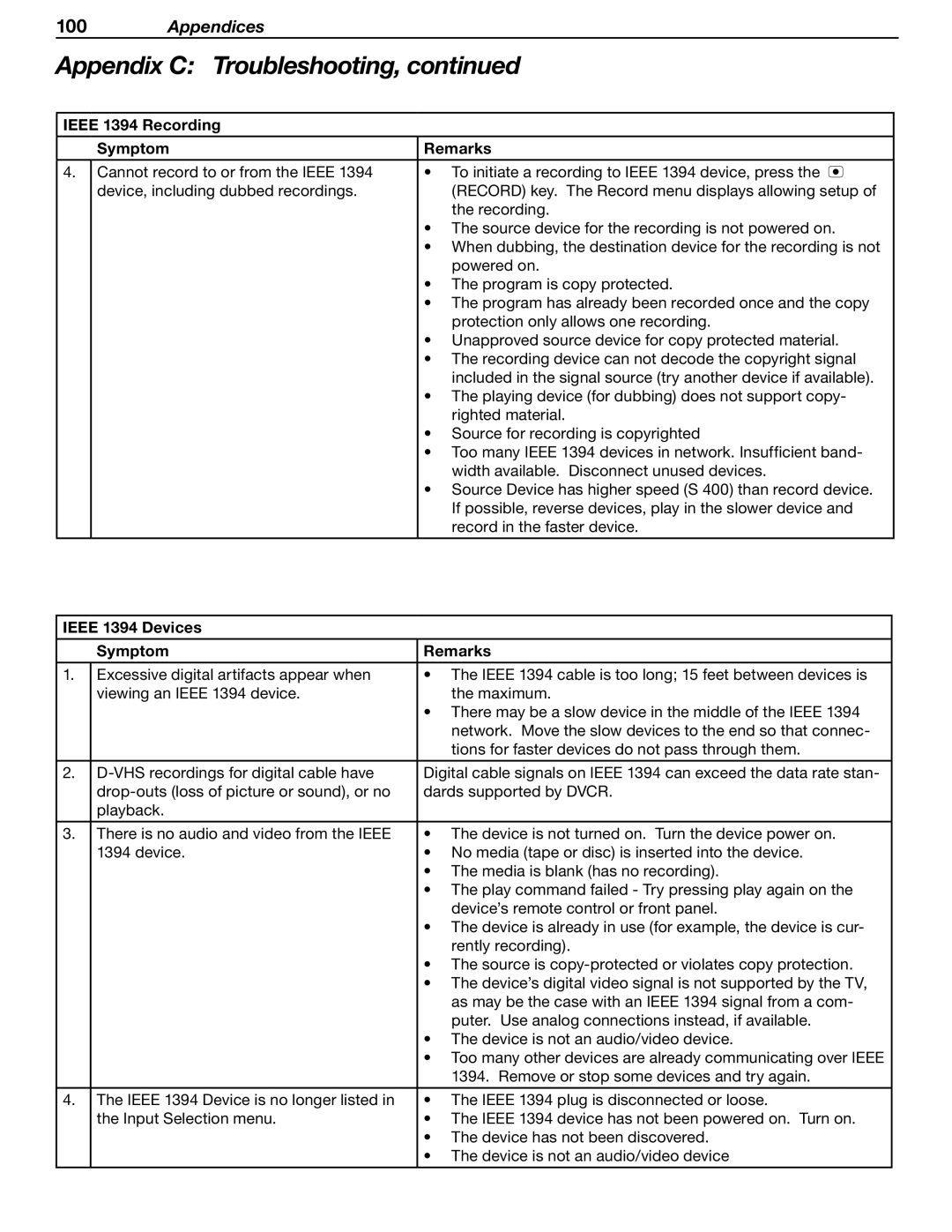
100Appendices
Appendix C: Troubleshooting, continued
IEEE 1394 Recording
Symptom | Remarks |
4. Cannot record to or from the IEEE 1394 | • To initiate a recording to IEEE 1394 device, press the |
device, including dubbed recordings. | (RECORD) key. The Record menu displays allowing setup of |
| the recording. |
•The source device for the recording is not powered on.
•When dubbing, the destination device for the recording is not powered on.
•The program is copy protected.
•The program has already been recorded once and the copy protection only allows one recording.
•Unapproved source device for copy protected material.
•The recording device can not decode the copyright signal included in the signal source (try another device if available).
•The playing device (for dubbing) does not support copy- righted material.
•Source for recording is copyrighted
•Too many IEEE 1394 devices in network. Insufficient band- width available. Disconnect unused devices.
•Source Device has higher speed (S 400) than record device. If possible, reverse devices, play in the slower device and record in the faster device.
IEEE 1394 Devices
| Symptom | Remarks | |
|
| ||
1. | Excessive digital artifacts appear when | • The IEEE 1394 cable is too long; 15 feet between devices is | |
| viewing an IEEE 1394 device. |
| the maximum. |
|
| • There may be a slow device in the middle of the IEEE 1394 | |
|
|
| network. Move the slow devices to the end so that connec- |
|
|
| tions for faster devices do not pass through them. |
2. | Digital cable signals on IEEE 1394 can exceed the data rate stan- | ||
| dards supported by DVCR. | ||
| playback. |
|
|
|
|
|
|
3. | There is no audio and video from the IEEE | • | The device is not turned on. Turn the device power on. |
| 1394 device. | • No media (tape or disc) is inserted into the device. | |
|
| • The media is blank (has no recording). | |
|
| • The play command failed - Try pressing play again on the | |
|
|
| device’s remote control or front panel. |
|
| • The device is already in use (for example, the device is cur- | |
|
|
| rently recording). |
|
| • The source is | |
|
| • The device’s digital video signal is not supported by the TV, | |
|
|
| as may be the case with an IEEE 1394 signal from a com- |
|
|
| puter. Use analog connections instead, if available. |
|
| • The device is not an audio/video device. | |
|
| • Too many other devices are already communicating over IEEE | |
|
|
| 1394. Remove or stop some devices and try again. |
|
|
| |
4. | The IEEE 1394 Device is no longer listed in | • The IEEE 1394 plug is disconnected or loose. | |
| the Input Selection menu. | • | The IEEE 1394 device has not been powered on. Turn on. |
|
| • The device has not been discovered. | |
|
| • The device is not an audio/video device | |
|
|
|
|
